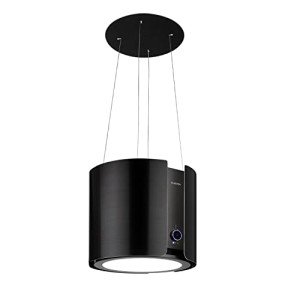The History Of Island Vent Hood
페이지 정보

본문

The Island Vent Hood: A Comprehensive Guide to Choosing and Installing the Perfect Kitchen Feature
In modern kitchen style, the island kitchen extractor hoods vent hood has actually become an important focal point, effortlessly integrating functionality with visual appeal. With the rise of open-concept living spaces, where cooking areas are incorporated with dining and living areas, the value of a well-designed ventilation system has actually ended up being vital. This post explores what an island vent hood is, the numerous types offered, crucial functions to consider, setup suggestions, view fakenews.win and FAQs surrounding this essential kitchen part.
What is an Island Vent Hood?
An island vent hood is a kitchen ventilation system created to be set up above an island cooktop or range. Unlike traditional wall-mounted hoods, premium island range hood hoods are suspended from the ceiling, providing a clear view of the cooking location while efficiently eliminating smoke, steam, and odors from the kitchen. This makes island hoods an appealing option for extractor fan for island hob (https://wifidb.science/) open designs while ensuring a tidy and comfortable cooking environment.
Types of Island Vent Hoods
When selecting an island vent hood, it is crucial to comprehend the different types offered in the market. Here are the primary classifications:
| Type | Description |
|---|---|
| Ducted | Ventilation is directed outside, offering the best air quality by expelling air and smells. |
| Ductless | Utilizes filters to clean the air and recirculate it back into the kitchen; simpler to install. |
| Convertible | Can operate in both ducted and ductless modes, offering versatility in setup. |
| Under-Cabinet | Installed under cabinetry; normally lower output, suitable for smaller sized kitchen layouts. |
Secret Features to Consider
Selecting the right island vent hood includes a number of important elements. Here are the important functions to consider:
- Size: The hood needs to be at least as large as the cooktop. Preferably, it needs to extend 6 inches on either side for optimal performance.
- CFM Rating: The Cubic Feet per Minute (CFM) ranking suggests the hood's ventilation power. Greater CFM is needed for heavy cooking, while lower CFM may suffice for lighter usage.
- Noise Level: Measured in sones, a lower sone ranking indicates a quieter operation. A quiet fan is especially crucial in open-concept spaces.
- Lighting: Many island hoods come equipped with built-in lighting. LED lights are popular for their energy efficiency and durability.
- Design: Island vent hoods can be found in different designs, including modern, standard, island range hood and industrial. Pick a hood that matches the general kitchen aesthetic.
Installation Tips
Installing an island vent hood can be a complex process. Here are some necessary suggestions to assist in the setup:
- Check regional codes and policies to ensure compliance with setup height and electrical requirements.
- Identify the hood's height: The top of the hood should be 30 to 36 inches above the cooking surface, depending upon the maker's suggestions.
- Secure the mounting bracket: Ensure that the installing bracket is properly anchored to the ceiling to support the weight of the hood and motors.
- Ductwork considerations: If using a ducted system, guarantee proper duct size and layout for optimum airflow. Avoid sharp bends in ducting, which can restrain air movement.
- Electrical setup: Ensure that the electrical connections satisfy your hood's power requirements, and consider hiring a licensed electrician for complex setups.
Expense Considerations
The expense of an island vent hood can range significantly depending on functions, materials, and brand name. Below is a breakdown of potential expenses related to purchasing and setting up these hoods:
| Cost Element | Estimated Range |
|---|---|
| Fundamental Models | ₤ 300 - ₤ 600 |
| Mid-range Models | ₤ 600 - ₤ 1,200 |
| High-End Models | ₤ 1,200 - ₤ 3,000+ |
| Installation Costs | ₤ 200 - ₤ 500 |
Frequently Asked Questions
1. How often should I clean my island hob extractor vent hood?Regular cleaning is encouraged, with deep cleaning a minimum of once a month, particularly if you prepare frequently. 2. Can I install an island vent

hood myself?While it is possible, professional
installation is suggested for safety and optimum performance, particularly with ductwork and electrical connections. 3. Are ductless island hoods effective?Ductless hoods can effectively filter
smoke and odors, however they might not be as effective as ducted designs. They need routine filter replacements and upkeep. 4. What sort of maintenance does an island vent hood require?Regular cleansing of filters, lights, and hoods, along with checking for any wear and tear on motors or ductwork is crucial for maintaining performance
. 5. What kind of filters should I use?Most island kitchen extractor hoods vent hoods utilize aluminum or charcoal filters. Aluminum filters are multiple-use, while charcoal filters need to be replaced
periodically. The island vent hood is a crucial element of a modern kitchen, offering exhaustion of undesirable smells and making a striking design declaration. Picking the ideal type, understanding important
features, and sticking to correct setup techniques will make sure ideal performance and durability of this kitchen device. Whether you are a seasoned chef or a periodic home cook, the best island vent hood can dramatically boost your cooking experience. By following the standards and considerations detailed in this article, homeowners can make informed choices and take pleasure in a cleaner and more enjoyable cooking environment.
- 이전글Guide To Island Cooker Hood: The Intermediate Guide To Island Cooker Hood 25.05.20
- 다음글15 Up-And-Coming Toyota Replacement Key Bloggers You Need To Keep An Eye On 25.05.20
댓글목록
등록된 댓글이 없습니다.